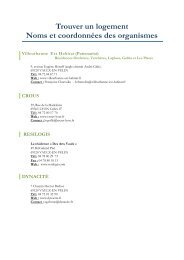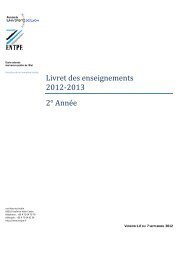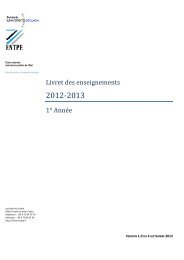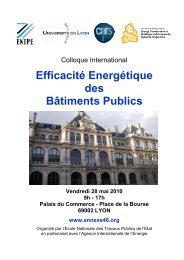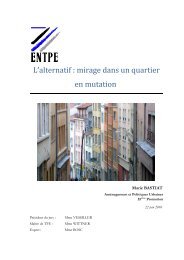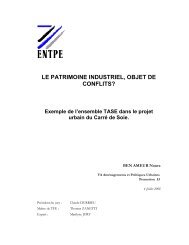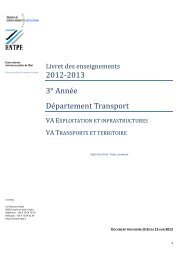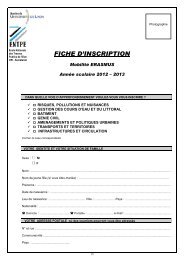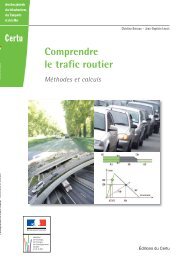Transformation urbaine et appropriation des espaces ... - entpe
Transformation urbaine et appropriation des espaces ... - entpe
Transformation urbaine et appropriation des espaces ... - entpe
You also want an ePaper? Increase the reach of your titles
YUMPU automatically turns print PDFs into web optimized ePapers that Google loves.
<strong>Transformation</strong> <strong>urbaine</strong> <strong>et</strong> <strong>appropriation</strong> <strong>des</strong> <strong>espaces</strong> extérieurs : Les limites du modèle de la résidentialisation.<br />
NOTICE ANALYTIQUE<br />
NOM PRENOM<br />
AUTEUR ARANTES Laëtitia<br />
TITRE DU TFE <strong>Transformation</strong> <strong>urbaine</strong> <strong>et</strong> <strong>appropriation</strong> <strong>des</strong> <strong>espaces</strong> extérieurs : les limites du<br />
modèle de la résidentialisation.<br />
ORGANISME D'AFFILIATION ET<br />
LOCALISATION<br />
NOM PRENOM<br />
MAITRE DE TFE BELMESSOUS Fatiha<br />
COLLATION 205 pages<br />
4 annexes<br />
(14 pages)<br />
142 références<br />
bibliographiques<br />
MOTS CLES Résidentialisation – Grands ensembles – Appropriation - Sociabilité<br />
TERMES<br />
GEOGRAPHIQUES<br />
Quartier Teisseire - Grenoble<br />
RESUME Expérimentée par les professionnels de l’urbanisme depuis plus de quinze ans,<br />
la résidentialisation, consacrée en France par la loi du 1 er août 2003, fait aujourd'hui<br />
partie <strong>des</strong> outils courants du renouvellement urbain appliqués dans les grands<br />
ensembles d’habitat social.<br />
Si elle nourrit <strong>des</strong> ambitions <strong>urbaine</strong>s « classiques » - réintégrer le quartier à la<br />
ville, lui donner une nouvelle image, … -, elle cache toutefois <strong>des</strong> objectifs plus<br />
larges visant un certain contrôle <strong>des</strong> comportements, une certaine conformation<br />
<strong>des</strong> habitants à un modèle puisant ses préceptes dans la ville « traditionnelle » à<br />
laquelle les grands ensembles se sont toujours opposés.<br />
Mais transformer de la sorte ces quartiers, en aménageant <strong>des</strong> résidences, suffitil<br />
à modifier positivement le rapport <strong>des</strong> individus à leur espace <strong>et</strong> à leur habitat ?<br />
S’appuyant sur un exemple concr<strong>et</strong> de résidentialisation en cours – Teisseire à<br />
Grenoble – ce travail propose donc de donner la parole aux habitants <strong>et</strong> de cerner<br />
les modifications effectives engendrées par la résidentialisation sur leurs mo<strong>des</strong><br />
d’habiter.<br />
ABSTRACT Tried out by urban planners for more fifteen years, “residentialisation”,<br />
enshrined in French Law since August 1, 2003, has now become one of the current<br />
tools of urban renewal for social housing estates.<br />
While it has “standard” urban objectives – to reinstate the neighbourhood to<br />
the city, to give it a new image … -, it on the other hand conceals bigger purposes,<br />
which aim at some behaviour control, some inhabitant conformation to a<br />
traditional model, used to be opposed to social housing estates.<br />
However, do change in this way these neighbourhoods, by developing<br />
residences, suffice to positively modify people behaviours towards their<br />
environment?<br />
Based on a current residentialisation example – Teisseire in Grenoble -, this<br />
work proposes to call upon inhabitants to speak, and to define what the effective<br />
changes are in their way to live in their “residential” neighbourhood.<br />
ARANTES Laëtitia 2



